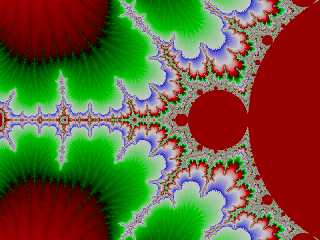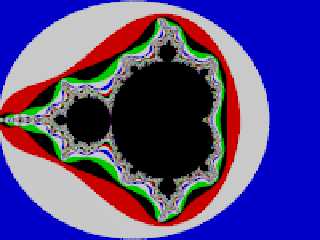 |
 |
|
 |
|
 |
|  |
|  |
|
 |
|
 |
|  |
|  |
|
 |
...in the mandel pool.
Small picture is a classical Mandelbrot set, at usual scale.
The other is about <-1.5099872678075,0>/2
with an iteration limit of 999 999 and a zoom factor of 99 999 999.
(just testing an exterior_type)
Post a reply to this message
Attachments:
Download 'pigment.png' (576 KB)
Download 'pigment7.png' (17 KB)
Preview of image 'pigment.png'

Preview of image 'pigment7.png'

|
 |
|  |
|  |
|
 |
|
 |
|  |
|  |
|
 |
Le_Forgeron <jgr### [at] free fr> wrote:
> ...in the mandel pool.
>
> Small picture is a classical Mandelbrot set, at usual scale.
>
> The other is about <-1.5099872678075,0>/2
> with an iteration limit of 999 999 and a zoom factor of 99 999 999.
> (just testing an exterior_type)
Did you use log smoothing for the exterior in the larger image? If so, do you
know if it's possible to bridge iterations perfectly, or are there always going
to be slight inconsistencies? I've gotten *pretty* close, but sometimes there
are still visible artifacts. I had to adjust the size function to (x*x+y*y)-2048
in order to get the best results. The coloring function reflects that
adjustment:
log(log(iters)/log(x*x+y*y))/log(2)/(i-1)-(i-1)/iters+512/(i-1)/iters
Rather ugly, I'd say, but it's the best I have come up with :\
Also, what kind of system are you using to navigate the fractal? Are you taking
parameters from other programs? What I'm doing now is placing a numbered, static
grid over the entire image and alternating between scale and translate
statements (using the grid as a reference), but there must be an easier way.
Sam fr> wrote:
> ...in the mandel pool.
>
> Small picture is a classical Mandelbrot set, at usual scale.
>
> The other is about <-1.5099872678075,0>/2
> with an iteration limit of 999 999 and a zoom factor of 99 999 999.
> (just testing an exterior_type)
Did you use log smoothing for the exterior in the larger image? If so, do you
know if it's possible to bridge iterations perfectly, or are there always going
to be slight inconsistencies? I've gotten *pretty* close, but sometimes there
are still visible artifacts. I had to adjust the size function to (x*x+y*y)-2048
in order to get the best results. The coloring function reflects that
adjustment:
log(log(iters)/log(x*x+y*y))/log(2)/(i-1)-(i-1)/iters+512/(i-1)/iters
Rather ugly, I'd say, but it's the best I have come up with :\
Also, what kind of system are you using to navigate the fractal? Are you taking
parameters from other programs? What I'm doing now is placing a numbered, static
grid over the entire image and alternating between scale and translate
statements (using the grid as a reference), but there must be an easier way.
Sam
Post a reply to this message
|
 |
|  |
|  |
|
 |
|
 |
|  |
|  |
|
 |
Le 16/11/2010 23:26, Samuel Benge nous fit lire :
> Le_Forgeron <jgr### [at] free fr> wrote:
>> ...in the mandel pool.
>>
>> Small picture is a classical Mandelbrot set, at usual scale.
>>
>> The other is about <-1.5099872678075,0>/2
>> with an iteration limit of 999 999 and a zoom factor of 99 999 999.
>> (just testing an exterior_type)
>
(#declare n=399; value of fact & iter already provided)
pigment {mandel iter
exterior 7,n
interior 0,0.5
pigment_map{
[0.0 Blue]
[((n-1)/n)*1/5 White]
[((n-1)/n)*2/5 Red]
[((n-1)/n)*3/5 Black]
[((n-1)/n)*4/5 Green]
[((n-1)/n)*5/5 White]
[1.0 Red]
}
} translate <1.5099872678075,0,Radius>
scale fact
> Did you use log smoothing for the exterior in the larger image?
No, I used my own patched version to get a value based on the iteration
number at exit(e): (e % n) / n
With e the number of iteration at exit
and n the factor of the exterior
(instead of the classical type which return n / max iteration)
It does not fully cover [0..1], so I also made a type 8: (e % (n+1))/n
Still wondering which one is best.
(7 is easy to reserve the 1.0 for the interior, 8 has more coverage...)
> If so, do you
> know if it's possible to bridge iterations perfectly, or are there always going
> to be slight inconsistencies? I've gotten *pretty* close, but sometimes there
> are still visible artifacts. I had to adjust the size function to (x*x+y*y)-2048
> in order to get the best results. The coloring function reflects that
> adjustment:
> log(log(iters)/log(x*x+y*y))/log(2)/(i-1)-(i-1)/iters+512/(i-1)/iters
>
> Rather ugly, I'd say, but it's the best I have come up with :\
Euuuuhhhh, I do not understand the previous block.
But it might be an interesting idea to have a type based on log(iter).
Thanks for that.
>
> Also, what kind of system are you using to navigate the fractal? Are you taking
> parameters from other programs? What I'm doing now is placing a numbered, static
> grid over the entire image and alternating between scale and translate
> statements (using the grid as a reference), but there must be an easier way.
I tried Xaos & Xfractint, but I suck at finding / displaying the actual
coordinates, so I end up finding an easy to spot area of interest then
using increasing zoom within povray. fr> wrote:
>> ...in the mandel pool.
>>
>> Small picture is a classical Mandelbrot set, at usual scale.
>>
>> The other is about <-1.5099872678075,0>/2
>> with an iteration limit of 999 999 and a zoom factor of 99 999 999.
>> (just testing an exterior_type)
>
(#declare n=399; value of fact & iter already provided)
pigment {mandel iter
exterior 7,n
interior 0,0.5
pigment_map{
[0.0 Blue]
[((n-1)/n)*1/5 White]
[((n-1)/n)*2/5 Red]
[((n-1)/n)*3/5 Black]
[((n-1)/n)*4/5 Green]
[((n-1)/n)*5/5 White]
[1.0 Red]
}
} translate <1.5099872678075,0,Radius>
scale fact
> Did you use log smoothing for the exterior in the larger image?
No, I used my own patched version to get a value based on the iteration
number at exit(e): (e % n) / n
With e the number of iteration at exit
and n the factor of the exterior
(instead of the classical type which return n / max iteration)
It does not fully cover [0..1], so I also made a type 8: (e % (n+1))/n
Still wondering which one is best.
(7 is easy to reserve the 1.0 for the interior, 8 has more coverage...)
> If so, do you
> know if it's possible to bridge iterations perfectly, or are there always going
> to be slight inconsistencies? I've gotten *pretty* close, but sometimes there
> are still visible artifacts. I had to adjust the size function to (x*x+y*y)-2048
> in order to get the best results. The coloring function reflects that
> adjustment:
> log(log(iters)/log(x*x+y*y))/log(2)/(i-1)-(i-1)/iters+512/(i-1)/iters
>
> Rather ugly, I'd say, but it's the best I have come up with :\
Euuuuhhhh, I do not understand the previous block.
But it might be an interesting idea to have a type based on log(iter).
Thanks for that.
>
> Also, what kind of system are you using to navigate the fractal? Are you taking
> parameters from other programs? What I'm doing now is placing a numbered, static
> grid over the entire image and alternating between scale and translate
> statements (using the grid as a reference), but there must be an easier way.
I tried Xaos & Xfractint, but I suck at finding / displaying the actual
coordinates, so I end up finding an easy to spot area of interest then
using increasing zoom within povray.
Post a reply to this message
|
 |
|  |
|  |
|
 |
|
 |
|  |
|  |
|
 |
On 11/17/2010 9:31 AM, Le_Forgeron wrote:
>> If so, do you
>> know if it's possible to bridge iterations perfectly, or are there always going
>> to be slight inconsistencies? I've gotten *pretty* close, but sometimes there
>> are still visible artifacts. I had to adjust the size function to (x*x+y*y)-2048
>> in order to get the best results. The coloring function reflects that
>> adjustment:
>> log(log(iters)/log(x*x+y*y))/log(2)/(i-1)-(i-1)/iters+512/(i-1)/iters
>>
>> Rather ugly, I'd say, but it's the best I have come up with :\
>
> Euuuuhhhh, I do not understand the previous block.
>
> But it might be an interesting idea to have a type based on log(iter).
> Thanks for that.
I don't really understand it either; I snagged it from the fractal
forums and adjusted it to fit my function. It's nearly perfect, but not
enough for certain things...
>>
>> Also, what kind of system are you using to navigate the fractal? Are you taking
>> parameters from other programs? What I'm doing now is placing a numbered, static
>> grid over the entire image and alternating between scale and translate
>> statements (using the grid as a reference), but there must be an easier way.
>
> I tried Xaos& Xfractint, but I suck at finding / displaying the actual
> coordinates, so I end up finding an easy to spot area of interest then
> using increasing zoom within povray.
I've been using ChaosPro, but haven't tried to see if the coordinates
between it and my own functions match up or not.
It would be nice if POV allowed one to write their own fractal formulae
as a new fractal type. Or better yet, use complex numbers as native data
types. I'm currently struggling with imaginary numbers, so perhaps such
functionality would be a detriment to my own growth :/
Post a reply to this message
|
 |
|  |
|  |
|
 |
|
 |
|  |
|
 |




![]()